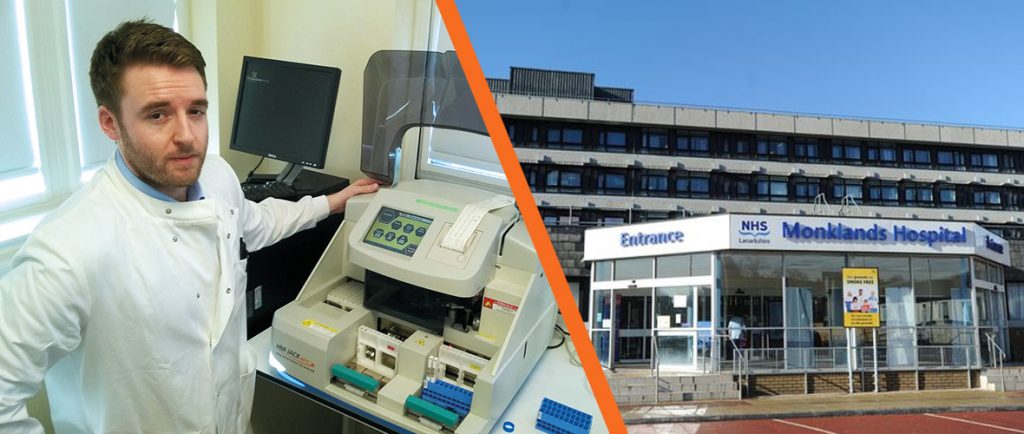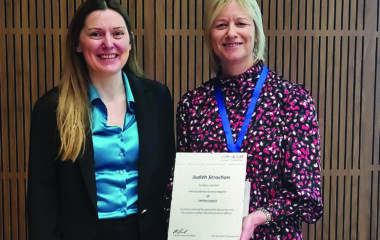- [email protected]
- +44 (0) 23 8048 3000
Evaluating a Faecal Immunochemical Test System for Symptomatic Patient Assessments
- Resource: Reports
- Date: November 10, 2017

Alan Hankinson, Senior Biomedical Scientist with the HM-JACKarc at Monklands Hospital
An interview with Dr Ian Godber, Consultant Clinical Scientist, Clinical Lead (Biochemistry),
Monklands Hospital, NHS Lanarkshire
Dr Ian Godber’s team at NHS Lanarkshire has evaluated the HM-JACKarc automated FIT analytical system for assessment of patients referred from primary care to endoscopy because of lower GI symptoms. As a result of this successful study, the process of rolling out a FIT service to their local General Practitioners (GP) is now well under way. Matthew Davis, Alpha Laboratories Senior Product Manager, met recently with Ian to find out more from one of the first hospitals in the UK to offer a quantitative Faecal Immunochemical Test for haemoglobin (FIT) service.
There was sufficient data in publications on FIT to suggest that the ability to “rule in” patients who potentially had cancer and fast track them through endoscopy was good. In addition, the potential to “rule out” patients with no significant pathology was interesting from a cost saving and improved efficiency perspective.
Matthew: What prompted your laboratory to consider providing the FIT service?
Ian: We initiated investigations on Faecal Immunochemical Tests for haemoglobin (FIT) due to the withdrawal of traditional guaiac-based gFOBT, following Professor Callum Fraser’s audit (ACB Scotland 2005). This highlighted that gFOBT should not be used to investigate symptomatic patients because of false positives and false negatives inherent when using this test. Our Gastroenterologists and GI surgeons agreed with the cessation of gFOBT but the knockon effect has been an increased demand for lower GI tract endoscopy. In consequence, we needed to find a way to relieve this additional pressure on the endoscopy service. The directorate structure of NHS Lanarkshire aided discussion. The divisional management to which I report is the same for both Diagnostics and Cancer Services, with similar structure and goals. This helped to simplify communication and coordination on this project.
Matthew: How did you engage with all the necessary departments to progress the pilot project?
Ian: There was sufficient data in publications on FIT to suggest that the ability to “rule in” patients who potentially had cancer and fast track them through endoscopy was good. In addition, the potential to “rule out” patients with no significant pathology was interesting from a cost saving and improved efficiency perspective. The proposal was taken to the Chief of Medicine for NHS Lanarkshire, at the Wishaw General Hospital site, Mr Hakim Ben Younes, who is also a GI surgeon, and he was keen to proceed. There was sufficient evidence to put the concept forward as a proposal to the Gastroenterologists, in order to relieve the pressure on the endoscopy service. This was a key factor in gaining approval to proceed with the project.
Matthew: What were the outcomes from the pilot project?
Ian: With support from Gastroenterologists and GI Surgeons, the project was driven forward to a successful conclusion, which resulted in a publication: Clin Chem Lab Med.2016 Apr;54(4):595-602. doi: 10.1515/cclm-2015-0617. The conclusions in the paper were essentially that the high negative predictive value of this test, at a cut off of 10μg Hb/g faeces, allows you to triage patients without missing any cancers, where the clinical sensitivity for colorectal cancer was 100%. In this study, all cancers had a f-Hb concentration greater than 150 μg Hb/g faeces. There still remain a number of questions, mainly around other bowel pathologies that also generate a positive FIT result, and how these patients are managed. It may be that patients with very high f-Hb concentrations, say 150μg Hb/g faeces are sent straight to endoscopy, whereas those who are below that, but above 10 μg Hb/g faeces, are followed up clinically. We think that there is potential to develop a clinical pathway that involves an initial screen with FIT, with patients then being seen in a clinic if the result is positive. The patient characteristics such as age, as well
as the symptoms, may lead the clinician down a different track, favouring referral to Gastroenterology, with the possibility of a calprotectin test being more appropriate. However, the higher the f-Hb concentration initially the more important it is to initiate an urgent colonoscopy. But, what about the negative FIT results? They may still need to be considered further and, depending on the clinical symptoms, there is possibly a case for following up these patients in 6 to12 months time with another FIT test.


